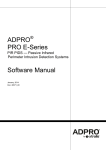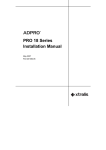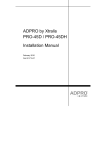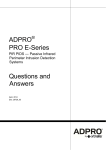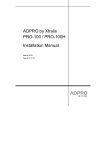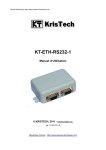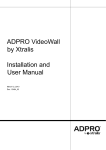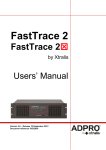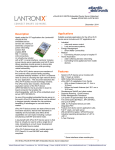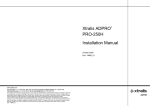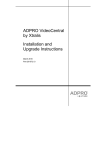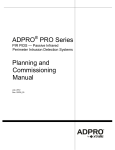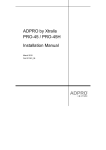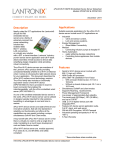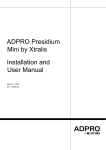Download ADPRO PRO E-PIR System Setup Manual
Transcript
ADPRO® PRO Passive-Infrared Perimeter Intrusion Detection Systems (PIR PIDS) System Setup Manual December 2014 Document: 26571_03 ADPRO PRO E by Xtralis System Setup Manual Intellectual Property and Copyright This document includes registered and unregistered trademarks. All trademarks displayed are the trademarks of their respective owners. Your use of this document does not constitute or create a licence or any other right to use the name and/or trademark and/or label. This document is subject to copyright owned by Xtralis AG (“Xtralis”). You agree not to copy, communicate to the public, adapt, distribute, transfer, sell, modify or publish any contents of this document without the express prior written consent of Xtralis. Disclaimer The contents of this document is provided on an “as is” basis. No representation or warranty (either express or implied) is made as to the completeness, accuracy or reliability of the contents of this document. The manufacturer reserves the right to change designs or specifications without obligation and without further notice. Except as otherwise provided, all warranties, express or implied, including without limitation any implied warranties of merchantability and fitness for a particular purpose are expressly excluded. General Warning This product must only be installed, configured and used strictly in accordance with the General Terms and Conditions, User Manual and product documents available from Xtralis. All proper health and safety precautions must be taken during the installation, commissioning and maintenance of the product. The system should not be connected to a power source until all the components have been installed. Proper safety precautions must be taken during tests and maintenance of the products when these are still connected to the power source. Failure to do so or tampering with the electronics inside the products can result in an electric shock causing injury or death and may cause equipment damage. Xtralis is not responsible and cannot be held accountable for any liability that may arise due to improper use of the equipment and/or failure to take proper precautions. Only persons trained through an Xtralis accredited training course can install, test and maintain the system. Liability You agree to install, configure and use the products strictly in accordance with the User Manual and product documents available from Xtralis. Xtralis is not liable to you or any other person for incidental, indirect, or consequential loss, expense or damages of any kind including without limitation, loss of business, loss of profits or loss of data arising out of your use of the products. Without limiting this general disclaimer the following specific warnings and disclaimers also apply: Fitness for Purpose You agree that you have been provided with a reasonable opportunity to appraise the products and have made your own independent assessment of the fitness or suitability of the products for your purpose. You acknowledge that you have not relied on any oral or written information, representation or advice given by or on behalf of Xtralis or its representatives. Total Liability To the fullest extent permitted by law that any limitation or exclusion cannot apply, the total liability of Xtralis in relation to the products is limited to: i. in the case of services, the cost of having the services supplied again; or ii. in the case of goods, the lowest cost of replacing the goods, acquiring equivalent goods or having the goods repaired. Indemnification You agree to fully indemnify and hold Xtralis harmless for any claim, cost, demand or damage (including legal costs on a full indemnity basis) incurred or which may be incurred arising from your use of the products. Miscellaneous If any provision outlined above is found to be invalid or unenforceable by a court of law, such invalidity or unenforceability will not affect the remainder which will continue in full force and effect. All rights not expressly granted are reserved. 26571_03 i System Setup Manual ADPRO PRO E by Xtralis Document Conventions The following typographic conventions are used in this document: Convention Description Bold Used to denote: emphasis Used for names of menus, menu options, toolbar buttons Italics Used to denote: references to other parts of this document or other documents. Used for the result of an action. The following abbreviations are used in this document. Abbreviation Description AA Aperture Angle CZ Creep Zone DR Detection Rate ESD Electrostatic Sensitive Device FAR False Alarm Rate GND Ground QSG Quick Setup Guide PID Perimeter Intrusion Detector PIDS Perimeter Intrusion Detection System PIR Passive-Infrared The following icons are used in this document: Convention Description Caution: This icon is used to indicate that there is a danger to equipment. The danger could be loss of data, physical damage, or permanent corruption of configuration details. Warning: This icon is used to indicate that there is a danger of electric shock. This may lead to death or permanent injury. Warning: This icon is used to indicate that there is a danger of inhaling dangerous substances. This may lead to death or permanent injury. Danger! This icon is used to indicate that there is a danger of falling down! There is acute danger, when working with unsecured ladders. Unsecured ladders can slip and cause a fall that can lead to serious injuries. Additional information: refer to local „Safety at Work Act“. Note! This icon is used to highlight useful advice and recommendations as well as information for an efficient and troublefree operation. ii 26571_03 ADPRO PRO E by Xtralis System Setup Manual Contact Us UK and Europe +44 1442 242 330 D-A-CH +49 431 23284 1 The Americas +1 781 740 2223 Middle East +962 6 588 5622 Asia +86 21 5240 0077 Australia and New Zealand +61 3 9936 7000 www.xtralis.com 26571_03 iii System Setup Manual ADPRO PRO E by Xtralis This page is intentionally left blank. iv 26571_03 ADPRO PRO E by Xtralis System Setup Manual Table of Contents 1 PRO E-Tool Software 1.1 1.2 1.3 2 3 3 13 35 iCommission 37 2.1 2.2 2.3 37 38 39 Front User Panel Overview iOS App Overview iCommission Installation and Alignment PRO E-IPM (IP Module) 43 3.1 3.2 3.3 43 44 51 Notes 26571_03 Software Installation Use of ADPRO PRO E-Tool Software Uninstall Software 3 System Overview xPico Module Setup (PRO (E) Series Detector) PC Setup (com0com with com2tcp) 54 1 System Setup Manual ADPRO PRO E by Xtralis This page is intentionally left blank. 2 26571_03 ADPRO PRO E by Xtralis 1 System Setup Manual PRO E-Tool Software 1.1 Software Installation The ADPRO ® PRO E-Tool for Windows® (XP, Win 7, Win 8) is available for download through www.xtralissecurity.com. It connects to PRO/PRO E-detectors through RS-232/USB/IP (through bus converters or virtual COM ports) and is used for setting up detectors during commissioning , optimizing the settings and monitoring detectors in use. It can be used for all types of detectors. The Software shows all current operation parameters and real time sensor signals of the selected detector. This is useful in various situations, such as realignment of the detector, adapting certain parameters or blanking out objects in the detection area causing unwanted alarms. The ADPRO PRO E-Tool for Windows® installation wizard allows you to easily install the Software by providing you with direct and easy-to-follow steps whether installation is made on an XP or Windows 7/8 platform. This section discusses how to install the Software on Windows 7/8 and XP platforms, in addition to configuring the communication port. 26571_03 3 System Setup Manual 1.1.1 ADPRO PRO E by Xtralis Installation on Windows 7/8 To install the Software on a Windows 7/8 platform, do the following: 1. 2. 3. 4. 5. Unzip the file “Setup_PROXX.zip”, Rename the file “Setup_PROXX.txt” to “Setup PROXX.exe”, Double click the file “Setup PROXX.exe”, a security warning window appears, Click “Run”, a user account control window appears, Click “Yes”, the ADPRO PRO E-Tool setup installation wizard starts and the following window appears: If you want to cancel the installation process, click “Cancel”, the following message appears: Click “Yes” to cancel the installation process, or “No” to resume it. You can reinstall the software later. 6. Click “Next”, the following window appears: You can save the ADPRO PRO E-Tool for Windows® in the selected folder or specify another one by clicking “Browse” then selecting it. 7. Click “Next”, the following window appears: 4 26571_03 ADPRO PRO E by Xtralis System Setup Manual The window shows where the software’s shortcuts will be created, if you want to specify another folder, click “Browse…” and select it. You can return to the previous window to make the changes you want by clicking “Back”. This button is available in all windows. 8. Click “Next”, the following window appears: The window shows the destination location and start menu folder you specified. 9. Click “Install”, the following window appears: 26571_03 5 System Setup Manual ADPRO PRO E by Xtralis 10. Wait till the installation is complete, the following window appears: 11. Click “Finish”. 6 26571_03 ADPRO PRO E by Xtralis 1.1.2 System Setup Manual Installation on XP To install the Software on an XP platform, follow these steps: 1. Unzip the file “Setup_PROXX.zip”, 2. Rename the file “Setup_PROXX.txt” to “Setup PROXX.exe”, 3. Double click the file “Setup PROXX.exe”,the ADPRO PRO E-Tool Software setup wizard starts and the following window appears: 4. Click “Next”, the following window appears: You can save the ADPRO PRO E-Tool for Windows® in the selected folder or specify another one by clicking “Browse” then selecting it. 26571_03 7 System Setup Manual ADPRO PRO E by Xtralis 5. Click “Next”, the following window appears: The window shows where the Software’s shortcuts will be created, if you want to specify another folder, click “Browse” and select it. 6. Click “Next”, the following window appears: The window shows the destination location and start menu folder you specified. 7. Click “Install”, the following window appears: 8. Wait till the installation is complete, the following window appears: 8 26571_03 ADPRO PRO E by Xtralis System Setup Manual 9. Click “Finish”. The ADPRO PRO E-Tool for Windows® is now installed in your computer in the specified directory and the following structure is created: Each sub-folder is responsible for a specification action as follows: Contains all images taken using the Software. Contains all detector configuration files. Contains all statistics and debugger files. Contains all detectors definition files. Each detector model requires its specific INI file. Contains specific data relevant to the display structure such as logo on images, etc. This file must not be deleted. Installation program for setup and signal display. 26571_03 9 System Setup Manual 1.1.3 ADPRO PRO E by Xtralis Configuration of Communication Port It is important to configure the communication port that will be dedicated to the Software before you start using it. If you are using a Windows 7/8 platform, follow these steps to configure the port: 1. 2. 3. 4. 5. Connect the “IFM-485-ST” to the available port, Right click “My Computer”, Click “Manage”, Click “Device Manager”, Click “Ports (COM and LPT)”, a list of available ports appears as shown below: 6. Right click “USB Serial Port (COM3)” to update its driver software, 7. Click “Update Driver Software…”, the following window appears: 8. Select “Search automatically for updated driver software”, the following window appears: 9. Wait for the search to complete, the following window appears: 10 26571_03 ADPRO PRO E by Xtralis System Setup Manual 10. Click “Close”. If you are using an XP platform, follow these steps to configure the communication port: 1. 2. 3. 4. 5. Right click “My Computer”, Click “Manage”, Click “Device Manager”, Click “Ports (COM and LPT)”, Right click “Communications Port (COM1)”, the following menu appears: 6. Click “Update Driver…”, the following window apppears: 7. Select “Install the software automatically (Recommended)”, 8. Click “Next”, the following window appears: 26571_03 11 System Setup Manual ADPRO PRO E by Xtralis 9. Wait while the wizard searches for the update, the following window appears: 10. Click “Finish”. Notes: l l l If your computer features a RS232 data bus, you can directly connect it to the IFM-485-ST via COM1 or COM2 without any additional drivers. Every time you change the communication port you are using, you need to reconfigure its driver software. Port number varies depending on the system you are using. For more information on how to associate the communication port with the Software, refer to "Select Communication Port). 12 26571_03 ADPRO PRO E by Xtralis 1.2 System Setup Manual Use of ADPRO PRO E-Tool Software As mentioned earlier, the Software helps you to optimize the settings and monitor the detector(s) in use. After you have successfully mounted the detector and configured the settings you need, you can start using the Software. Once installed, a shortcut for PRO 9.x is created and can be accessed through the applications menu, it appears as follows: The ADPRO PRO E-Tool for Windows® provides various tools and features that allow you to control and monitor the detectors and maximize their benefit. They are categorized into menus for easier access. In addition, you can access any tool or feature through the buttons that appear in the toolbar as follows: Symbol Action Open Detector INI (legacy feature, please do not use) Search Detector Up/download settings Debugger Statistics Scope View picture Run Stop Take picture As a general preference you can set the language and audible alarm indication. Language Selection The Software provides the settings and parameters in various languages displayed in this menu. To switch between the available languages, follow these steps: 1. Click “Options”, then “Language”, 2. Select the language you want. 26571_03 13 System Setup Manual ADPRO PRO E by Xtralis Parameters and settings are now displayed in the selected language, but as for the interface language itself it is only available in English. Audio ouput; Beep Click “Options”, then “Beep” If this option is checked, whenever the detector detects something, you’ll hear a beep. Moreover, the Software provides shortcuts through the keyboard for faster access to the required tool, as follows: Shortcut Action <F1> About the Software <F2> Open detector definition file window. <F3> Search for a detector. <F4> Up/Download <Ctrl> + B Beep <F5> Run scope <Ctrl> + <F5> Stop scope <F6> Change scroll direction, “right to left” or “left to right” <F7> Hide/ show grid <F8> Increase signal speed <Ctrl> + <F8> Decrease signal speed <F9> Clear scope <F10> Delete all triggers <Ctrl> + <K> Open scope window <Ctrl> + <P> Take picture <Ctrl> + <V> View picture <Ctrl> + <A> Picture auto <Ctrl> + <O> Picture memo <Ctrl> + <M> Open statistics window <Ctrl> + <T> Test <Ctrl> + <D> Open debugger window The following sections discuss all the actions you can perform, the available tools and how to use them. 14 26571_03 ADPRO PRO E by Xtralis 1.2.1 Connect to Detectors 1.2.1.1 File System Setup Manual Please note: This is a legacy feature, do not use it during normal operation. This option allows you to select the detector type to be expected by the software by preloading the respective INI file. If this selected type does not match the connected detector there will be this kind of error message: If you do not load any INI-File before selecting a detector, the software will automatically select the correct INI-File for you. If the error message above appears anyway, you’re software is not compatible with the detector, please connect our tech support for a software update. 1.2.1.2 Select Communication Port First select the communication port which is connected to the RS-485: 1. Click “Option”, 2. Click “Com Port”, a menu listing the available ports appears, 3. Select the port you want; it will be marked with a ( Note: 1.2.1.3 ) sign. Communication ports’ numbers vary according to the system you are using and available ports. Select detector Before you start using the ADPRO PRO E-Tool for Windows®, you need to select the detector to be used. The Software normally finds the detector’s definition file automatically. This step is only required if there is no automatic loading of the detector. There are two methods for selecting the detector in use in order to load its definition file and connect it to the RS-485 bus. 1. Click “Option”, 2. Click “Search Detector”, 3. Click “Start”, or press keys <ALT> + <S>, a list of found detectors appears as shown below: Note: 26571_03 Detectors are given IDs (addresses) in the range of 1 to 254. It is recommended to narrow down the range when searching for a detector so as not to take time and retrieve the connected detectors more quickly. Each detector must have a unique address. If more than one detector is given the same address 15 System Setup Manual ADPRO PRO E by Xtralis and is connected to the same bus, none of them will appear on the Software. To resolve this problem, disconnect all detectors and configure each one separately. This will ensure that no detector uses the same ID of another one. The number on the left of the “>” sign is the detector’s ID. The type of the detector and the firmware version number are on the right of the “>” sign. You can stop the search process by pressing <ALT> + <S> or clicking “Stop”. To close the search window, click “ESC”. If no detectors are found, the following message appears: Make sure you’ve selected the correct COM port (in which case the TX LED of the bus interface module should be blinking during the search and the RX LED should be blinking if a detector is found) and that the search range covers the detectors’ addresses. Click “OK”, check for errors, and repeat the search. 4. Select the detector you wish to use, or enter its address in “Choice” field, 5. Click “OK”. 1.2.2 Up/Download Settings The Software simplifies the process of detector configuration and allows you to save time spent in setting other detectors values. You can configure a detector and use the same settings for other detectors of the same type connected to the Software. You can manage setting options, upload a detector’s settings, download them from a definition file, and save them to a new definition file, etc. The Up/Download window has the following functions: Content and layout are detector-model-dependent and primarily designed to review and change the detector’s parameters. These include address, sensitivity, output functions, etc. 16 26571_03 ADPRO PRO E by Xtralis System Setup Manual It also shows the actions you can perform where each one is represented with a certain button as follows: Symbol Action Upload settings to detector Download detector’s settings Copy Insert Save to configuration file Load from configuration file Also, the above actions can be accessed by clicking “Setting”, the following menu appears: The following sections discuss all the actions you can perform, the available tools and how to use them. Note: Setting options depend on detector model. Displayed positions and displayed terms of option may vary depending on detector model. To select a detector to load its settings, you can: l Select the detector from the drop-down menu then click ( l Press <F3> and search for it by following the same steps mentioned in (Select detector), then click ( To close the Setting window after making, click ( Note: ). ). ). If you attempt to close the Settings window before saving the changes you make, the following message appears: If you are sure you want to exit the window without saving, click “Yes”; otherwise, click “No” then save the changes you made. Upload Settings To upload settings to detector, follow these steps: 1. Make the changes you want to the fields you can change, 2. Click ( Note: 26571_03 ). Successful upload is represented with ( Make sure to click ( ). ) to save the changes you made; otherwise, they are lost. 17 System Setup Manual ADPRO PRO E by Xtralis Factory Settings You can reinstate the factory default configuration to the detector instead of the changes you made in the following cases: l l The detector does not seem to work properly. A previous version of the ADPRO PRO E-Tool for Windows® was used on the same detector. To display and use the factory default settings, follow these steps: 1. Click “Factory”, the following message appears: 2. Click “Yes” to replace the values with the factory ones, 3. Click ( ) to save them in the detector’s configuration file. Download Settings To download the detector’s settings, follow these steps: 1. Make the changes you want, 2. Select the detector, 3. Click ( ). The configuration status is represented with the following symbols: Uploading configuration Changed configuration Communication problem Downloading configuration Copy Settings To copy the settings of a detector and use them in another one, follow these steps: 1. Select the detector which settings you want to copy, 2. Click ( ), 3. Select the detector to which you want to apply the copied settings, 4. Click ( ), 5. Save Settings to CFG File. To save the configuration in the “CFG” sub-folder accessed through the ADPRO PRO E-Tool for Windows® folder saved in the computer, follow these steps: 1. Make the changes you want, 2. Click ( 18 ), the following field appears: 26571_03 ADPRO PRO E by Xtralis System Setup Manual 3. Enter file name, 4. Click “OK” to save, or “Abort” to cancel the action. Load Settings from CFG File To load the configuration saved in a CFG file, follow these steps: 1. Click ( ), the following window appears: 2. Select the file, 3. Click “Open”, the configuration appears in the Settings window so you can make sure you are using the desired configuration. 4. Click ( 1.2.2.1 ) to upload settings to detector. Setting Options for PRO E and PRO E-RF Detectors The Setting window displays the setting options for the selected detector where each field represents a certain value as follows (e.g. PRO E-100H). 26571_03 19 System Setup Manual ADPRO PRO E by Xtralis List of settings for PRO E-detectors Choice Selectable list of all detectors connected to the same bus (i.e. COM port), which allows for convenient copy/paste-ing of common settings between the detectors. Address 1-255 Set detector’s identification bus address (1-255, default 1). Note: ATD ON Enables “Adaptive Threshold Determination”. OFF Disables “Adaptive Threshold Determination”. Note: Out x1 Make sure that each and every detector has an individual address from 1-255 before connecting them to a common bus. Disable ATD function prior to walking test to optimize performance of detector. ON Enables respective output relay. OFF Disables respective output relay. Delay Out x1 OFF adds a turn-off delay in ms, from 1/10s (100ms) to 1min (60000ms), (default 2500). Sensitivity CZ/Zone x/Main 0.5-1. Sets sensor sensitivity in creep zone (360PROtect) / in the main IR detector zone or in the different zones 1-3 or 1-6, (depending on number of available channels) from 50% (0.5) to 150% (1.5), (default 1.0). Out x inverse3 OFF Relay opens upon alarm, normally closed (default off). ON Relay closes upon alarm, normally open. OFF Disables legacy mode (default off). ON Enables legacy mode, which allows alarm management with PRO detector protocol without the PRO E enhancements. This means, that new events, like 360PROtect alarm and anti-masking alarm are assigned to existing events. ON Enables the 360PROtect sensor (default on). OFF Disables the 360PROtect sensor. Legacy mode CZ coverage 20 26571_03 ADPRO PRO E by Xtralis Pulse count2 System Setup Manual 0 - 10 Number of additional pulses (0 – 10) before an alarm is generated. OFF Triggers alarm on first pulse. Reset alarm counter Select “on” to resets internal alarm counter. Reset Vandal position Select “on” to write new alignment position into non-volatile RAM as baseline for tamper protection in case of incorrect alignment of the detector. Reset anti masking Select “on” to writes new anti masking sensor reading into non-volatile RAM as baseline for masking protection in case of masking the front of the detector. 1 Standard PRO E-detectors have 3 outputs, while H-versions have 5 and PRO E-RF detectors have 1, thus each output related setting (activation, delay, reversal) occurs once, 3 or 5 times respectively. 2 Only for volumetric detectors, curtain detectors have no pulse count feature. 3 Does not apply to PRO E-RF detectors. 1.2.2.2 Setting Options for PRO Detectors This software is also fully compatible with all PRO detectors which have the following settings: (screenshot example shows a PRO-45DH in hardware configuration mode). Note: Several of the PRO detector settings have the prefix “SW”. This indicates, that they can be set here in software, but also in hardware through DIP switches. If the detector is set to software installation mode (DIP 1 and 2 both “ON”) these settings can be adjusted using this tool, if the detector is in hardware mode (DIP 1 and 2 in any other combination) those settings are greyed out and are controlled by DIP switch settings. See details in PRO detector manual “ADPRO PRO-Series EN, document no. (20780)”. List of settings for PRO detectors Choice Selectable list of all detectors connected to the same bus (i.e. COM port), which allows for convenient copying / pasting of common settings between the detectors. Address 1-255 Set detector’s identification bus address (1-255, default 1). Note: Configuration HW / SW Displays current operation mode: Hardware or Software. Note: 26571_03 Make sure that each and every detector has an individual address from 1-255 before connecting them to a common bus. Operation modes can only set by DIP-switches 1 and 2 on connector board of detector. 21 System Setup Manual Channel L/M/S 1) Output function [Relay | Transistor] ADPRO PRO E by Xtralis ON Long, medium and short range channels may be enabled individually by selecting “ON” from drop-down menu. OFF Long, medium and short range channels may be disabled individually by selecting “OFF” from drop-down menu. If relay function is set to “ON”, the following two options are available in the dropdown menu: 1. “IR + VAN | IR + VAN”: Using relay and transistor open collector to signal intrusion alarms and tamper alarms. 2. “IR + VAN”: Using only relay to signal intrusion alarms and using only transistor open collector to signal tamper alarms. This allows identifying alarms. Output [OC1 | OC2] 5) This feature is only available with intrinsically safe detectors. These detectors have two open collector outputs, which have to be connected via the recommended ex-barriers and through which two relay outputs can be used. The following options can be accessed via a drop-down menu: 1. “IR | VAN”: This serves to issue intrusion alarms on relay 1 and vandalism alarms on relay 2 at the ex-barrier, which serves to clearly distinguish the alarms. This is the factory setting. 2. “IR + VAN | IR + VAN”: This setting is used to issue both alarms at the same time for intrusion and vandalism on relays 1 and 2 at the ex-barrier. Therefore it is not possible to distinguish the alarms. Relay function OFF Disables output function of relay. ON Enables output function of relay. Normal Relay opens when in alarm. Inverted Relay closes when in alarm. Transistor output logic Normal OC opens when in alarm. Inverted OC closes when in alarm. Channel right/left 2) ON/ OFF Enables/ Disables right/ left channel. Relay output logic List of settings for PRO detectors SW sensitivity right/left [%] 2) Modifies sensitivity of right/left channel within bandwidth 20 % - 140%. SW range 4) Detection range can be individually set, . pre-set values vary depending on model. Reduction of overall sensitivity changes alarm threshold but leaves coverage of right/left channel unchanged. Reduction of nominal range affects only coverage of long-range channel. SW sensitivity [%] Modifies the overall sensitivity within a bandwidth 50% - 150% for long range (multichannel) detectors or 20%- 140% for mid-range (single channel) detectors. Reduction of overall sensitivity changes alarm threshold but leaves coverage of long-range channel unchanged. 22 26571_03 ADPRO PRO E by Xtralis SW ATD System Setup Manual ON Enables “Adaptive Threshold Determination”. OFF Disables “Adaptive Threshold Determination”. Note: SW Test (legacy feature) SW Vandalism protection OFF Regular operation, Do NOT enable unless using legacy walk tester CT-45 (default off). ON Enabled to perform walking test with legacy walk tester CT-45, do NOT enable it for current walk tester CT PRO/ CT PRO 2. ON/ OFF Enables/ Disables “Anti-Tamper Protection”. SW Mounting height HIGH 1) Reset vandal position Mounting height above than 3 m (10 ft). LOW Mounting height less than 3 m (10 ft). ON Writes new alignment position into non-volatile RAM as baseline for anti-tamper protection in case of misalignments. OFF Upload of settings to control device happens always automatically in “OFF”. - Not selected. Reset alarm counter ON SW pulse count 3) Disable ATD function prior to walking test to optimize performance of detector. When putting “SW Test” to “ON”, ATD function is disabled automatically in Software mode. Resets alarm counter to “zero” at next download of settings to detector. OFF No resetting of alarm counter to “zero” at next download of settings to detector. - Not selected. 0 - 10 Number of additional pulses (0 - 10) before an alarm is generated. OFF Triggers alarm on first pulse. Notes: 1) Applies only to long-range curtain detectors PRO-100/ PRO-100H and PRO-250H 2) Applies only to directional detectors PRO-45 and PRO-45H 3) Applies only to volumetric detectors 4) Applies only to long range detectors PRO-100/ PRO-100H and PRO-250H 5) Applies only to intrinsically safe detectors 26571_03 23 System Setup Manual 1.2.3 ADPRO PRO E by Xtralis Output settings (PRO E-detectors only) The detector allows to freely assign different output events to all available output relays. Enter the output setting mode via top menu “Settings” → “Output Settings”. Notes: l l Accessing the Output Settings on a PRO detector will result in an empty window. The output settings will be deactivated (grey) if connected to a PRO E-RF detector. The “output setting window” allows to match 3 or 5 output relays (5 for H models) with any kind of event or alarm the connected detector can create. Example one, default settings, three outputs available, standard PRO E-detector, (screenshot below: PRO E-45, single zone; thus out 4 and 5 greyed out, one zone, no pulse count event; default settings). 1. Alarm: 360PROtect™ (creep zone and behind detector) and main zone trigger output 1. Anti-masking triggers output 1 as well, but together with output 3. 2. Tamper: tamper switch in main housing and in bracket and any misalignment trigger output 2. 3. Fault: Power supply or outside temperature outside of specified range (e.g. supply voltage too low, outside temperature too high) failure or if the outside temperature is out of range of the specified operational range. Anti-masking triggers output 3 as well, but together with output 1. Example two, using all five relays available on a PRO E H-detector: (screenshot below: PRO E-100H, three zones, no pulse count event; default settings). 24 26571_03 ADPRO PRO E by Xtralis System Setup Manual 1. Alarm: Zones 1-3 (here: L, M, S) trigger output 1. 2. Tamper: tamper switch in main housing and in bracket and any misalignment trigger output 2. 3. Fault: Power supply or outside temperature outside of specified range (e.g. supply voltage too low, outside temperature too high) failure or if the outside temperature is out of range of the specified operational range. 4. Config1: Anti masking triggers output 4. 5. Config2: 360PROtect (creep zone) triggers output 5. Example three, alarm localisation, each zone triggers its own alarm. Example four, Legacy-mode, using only 2 Outputs: In case the PRO E-detector replaces an older PROdetector in an existing installation, you need to bundle the 5 Outputs into 2 Outputs to maintain all functions of PRO E-detectors without changing the existing cabling. 26571_03 25 System Setup Manual 1.2.4 ADPRO PRO E by Xtralis Oscilloscope View (Scope) The Scope view is the most powerful feature of the software. The software starts up in the scope view and will re-enter it at any time pressing the scope icon ( through the “tool” menu, clicking “scope view”. ) or It shows in real-time the signal strength of each zone, if the monitored detector features multiple detection zones. Simultaneously, it shows the actual alarm threshold, the general alarm status, and various parameters such as total alarm count, strongest signal level received, and current settings of the DIP switches in the detector, etc. Through this menu you can manage the Scope view by stopping or running it, selecting the view mode, increase or decrease signal speed, etc. Scope menu appears as shown below: 26 26571_03 ADPRO PRO E by Xtralis System Setup Manual Scope view appears as follows (example PRO E-45): The Scope view illustrates the cause/response relationship between inputs and output. The view shows all signals and their levels on a time axis; it allows for a detailed analysis of the detector’s operation. The Scope view appears automatically after a detector has been selected from the search list. The signals on the screen represent the current readings of the detector and are helpful for resolving problems as well as managing certain installation features. The Scope window is divided into the following parts: l Scope view (black, left): Scope view is used to for signal monitoring; it shows IR amplitude, alarmthreshold and other vital parameters in real-time. In addition, it shows a varying amount of lines as follows: l Green (Sensor Signal): shows the signal levels of the PIR sensor. l Red (IR Alarm): shows the IR event caused by the sensor signal. l Purple (output alarms): shows the actual output signal at relay, depending on model and setup up to 5 signals, General, Sabotage, Fault, Config1 and Config 2. l Blue (Alarm threshold). l Yellow (Vandalism Alarm). Shows the detector has been misaligned. Note: l Alarms appear on Scope view only if the alarm generating detector is selected. Table of Settings (top-right): This table shows the current settings of the selected detector; it consists of the detector’s parameters such as sensitivity, desired detection range, their values and unit. 26571_03 27 System Setup Manual ADPRO PRO E by Xtralis To view the values of a certain parameter, click it, its values appear as shown below: PRO E-100H PRO-100H The selected parameter’s values appear in view-mode only. Any changes made to the settings are directly reflected on this table and the threshold. At the bottom is the firmware ID (FLD<>) and the used COM port number with address of current detector. Note: Information displayed in table varies depending on detector model. PRO detector also show the real time status of their DIP switches in the lower right corner. You can control the Scope view through the following: Action Button Shortcut Run the Scope Run <F5> Stop the Scope Stop <Ctrl> + <F5> Select Scope view mode Scroll Mode <F6> Grid <F7> Increase signal speed Step up++ <F8> Decrease signal speed Step down- - <Ctrl> + <F8> Clear Scope view Clear <F9> Delete all triggers Trigger Delete ALL <F10> As shown in the table above, there are two scope modes: l l 28 Scroll Mode: If checked, the signal is continuous and its direction is from right to left. If unchecked, the signal’s direction is from left to right and each time <F6> key is pressed the signal starts from the beginning. To switch between scroll modes press <F6>. Grid: If selected, horizontal and vertical lines appear on the Scope in addition to the signals. 26571_03 ADPRO PRO E by Xtralis 1.2.5 Further features 1.2.5.1 Screen shot System Setup Manual This tool enables you to take pictures of the Scope view and save them in the “BMP” sub-folder accessed through the ADPRO PRO E-Tool for Windows® folder. You can use them to compare readings, monitor readings on certain times, etc. To take a picture and save it, follow these steps: 1. Click “tool” menu” and “Picture take” or press the screen shot icon ( ) and the following field appears: 2. Enter your comment, 3. Click “OK”. The picture is saved as a BMP and as a PNG file and given a name according to the following naming convention: “Model-yymmdd_nnn.txt” where yy Year mm month dd Day nnn sequential number (1 - 999) e.g. PRO_E-100H-140624_001.png 26571_03 29 System Setup Manual ADPRO PRO E by Xtralis To view a picture, open it from the computer, it appears as follows: The image shows the scope, comment, and settings at the time that picture was saved. The screenshots can also be viewed from the software itself as explained in the next section. 30 26571_03 ADPRO PRO E by Xtralis 1.2.5.2 System Setup Manual Picture View You can view the pictures directly from the Software for easier access by clicking “Picture view”. The following window appears: The window is divided into two parts: the left one lists all the pictures and the right a preview of the selected picture. To delete a picture, follow these steps: 1. Select the picture, its name is displayed in the field, 2. Click “Delete”. It is immediately deleted from this window and from the “BMP” folder as well. To close the window, click ( ). Picture Auto If this feature is checked, each time the detector reads a signal or detects a movement, a picture is automatically taken and saved in the “BMP” folder. Picture Memo If this feature is checked, the “Picture take” tool is activated and you can take pictures of the Scope. 1.2.5.3 Statistics Through this feature you can view data the detector transmits to the controller. The Statistics view logs the actual alarm status of all detectors that have been discovered during the initial “Search for Detectors” process. In addition to general alarm information, the view details the zone that issued the alarm. It also shows warnings and detector‘s status under the system column. Every status change from every detector adds a line in this log view. This information is stored in text files on a daily basis, one file per detector. Files are saved in the “DAT” subfolder accessed through the ADPRO PRO E-Tool for Windows® folder. Click “Statistics”, the following window appears: 26571_03 31 System Setup Manual ADPRO PRO E by Xtralis The window is divided into the following sections: l l Connected Detectors (1): displays all connected detectors with information about identification number, firmware version number and alarm counters. Type (2): Each symbol indicates a status as follows: l ( ): connected. ( ): not connected. Log (3): displays the actual log. l l To generate a statistics file and save it, follow these steps: 1. Enter file name, 2. Click ( Note: 32 ) to start the viewing the transmitted data, it appears as in the example on the next page: A line is created for each detected event, along with the date and event description. 26571_03 ADPRO PRO E by Xtralis System Setup Manual List of all connected detectors, their types, Firmware version and number of alarms since beginning of recording. This example shows three Detectors connected, 4 and 5 have one Temper (T: 01) Alarm in the counter (“T: 01”) The events are listed real time below (4 and 5 “System=-V” for Vandal). Abbreviation Event GA General Alarm T Temper P Power faults CZ Creep zone (PRO-E only) Ax Alarm in respective Zone S, M or L Wx Warning in respective Zone S, M or L V Vandal Wx Warning in respective Zone S, M or L 3. Click ( ) to stop the process and save the file. The file is saved in the “DAT” folder and named according to the following naming convention: “STAz-yymmdd_nnn.xxx” z number of statistics file yy year mm month dd day nnn sequential number (1 - 999) xxx address number 1.2.5.4 Note: Debugger This feature of PRO E-Tool offers no benefits for commissioning, maintenance and fine tuning. The debugger is specifically meant for software developers to debug their protocol implementation by giving the opportunity to view, analyse and record the whole data stream of the RS 485 bus. The debugger helps record all communication made between the detector and computer and save this information in files stored in the computer. These files are saved in the “DAT” sub-folder accessed through the ADPRO® PRO E-Tool for Windows® folder. Click “Debugger” to open the Debugger window, it appears as follows: 26571_03 33 System Setup Manual ADPRO PRO E by Xtralis To start recording of data traffic and save this information in the computer, follow these steps: 1. Click the checkbox next to “Communication”, the window appears as follows: 2. Click “New File”. Data is saved in the file; you can create another file by clicking “NewFile”. To stop recording of data, click “Clear”. Files are named according to the following naming convention: “DBG-yymmdd_nnn.txt” where yy year mm month dd day nnn sequential number (1 - 999) The following abbreviations are used in data recording: Abbreviation Error ErrA Error counter ErrK Error counter configuration ErrW Error counter working ErrP Error counter synchronisation ChkSum Error counter check sum Tmo Error counter timeout Buf Error counter buffer 34 26571_03 ADPRO PRO E by Xtralis 1.3 System Setup Manual Uninstall Software You might need to uninstall the ADPRO PRO E-Tool for Windows® for any reason; the Software enables you to do so by providing you with a user-friendly wizard. To uninstall the Software, follow these steps: 1. Open the folder in which you have installed the Software, 2. Double click on “unist000.exe”, the following message appears: 3. Click “Yes”, the following window appears: 4. Wait till the uninstallation process is complete, the following message appears: 5. Click “OK”. 26571_03 35 System Setup Manual ADPRO PRO E by Xtralis This page is intentionally left blank. 36 26571_03 ADPRO PRO E by Xtralis 2 System Setup Manual iCommission iCommission is a unique one-man-commissioning tool which helps to vertically align a PRO E detector from a distance of up to 220 meters. It consists of: l l The iCommission unit, which hooks onto the vertical alignment screw on the detector. The iCommission iOS app for compatible iOS devices (Apple iPhone, iPad, iPod touch). Front view with user panel 2.1 26571_03 Rear view with WiFi antenna, 4mm Allen/Hex key driver and clamps Front User Panel Overview 1 RP-SMA-connector Use to install included WiFi antenna 2 Power LED Lit when unit is switched on 3 Charge LED Lit while unit is being charged 4 Motor LED Lit while detector is moving up or down 37 System Setup Manual 2.2 38 ADPRO PRO E by Xtralis 5 Mini-USB port Charge iCommission with USB charger 6 ON/OFF button Press to switch iCommission on/off 7 DOWN button Press to lower detector 8 UP button Press to raise detector iOS App Overview 1 WiFi indication Shows connection status between iOS device and iCommission unit 2 Speed selection Roll to select speed of movement from slow (1) to fast (10) 3 Battery indicator Shows charge level of iCommission battery 4 UP button Tap for brief or hold for continuous raising of the detector 5 Down button Tap for brief or hold for continuous lowering of the detector 26571_03 ADPRO PRO E by Xtralis 2.3 System Setup Manual iCommission Installation and Alignment To install the tool and align the detector, follow these steps: 1. Search for “Xtralis” in the App Store, scroll to the iCommission app and tap “GET” to install it. 2. Make sure that the iCommission unit is fully charged, using an USB charger and a mini USB cable, place it on the vertical alignment screw of the PRO E detector as shown below: 3. Make sure that the 4mm hexagon driver connects inside the alignment screw and the outside clamps lock properly on the bracket. 4. Switch on the unit by pressing the left button until the LED switches on. After a few seconds, the iCommission creates its own WiFi hotspot with the following details: SSID: iCommission-by XTRALIS Password: 12345678 26571_03 39 System Setup Manual ADPRO PRO E by Xtralis 5. Use the up/down buttons on the front panel to rough-align the detector (see the ADPRO PRO E PIR Installation Manual, document no. (27386), section "Alignment with the help of the telescope"). 6. Perform walk test at ¼, ½ and full nominal range. 7. Use CT PRO 2 (see the ADPRO PRO E PIR Installation Manual, document no. (27386), section "CT PRO – wireless walk tester"), iPIR app with FastTrace 2 or remote controlled PC running PRO SW to determine performance and fine tune sensitivity. If performance is still unsatisfactory, start the iCommission app and remotely change the vertical alignment up or down until the required performance is reached. 40 26571_03 ADPRO PRO E by Xtralis System Setup Manual When the detector has full performance across the desired range, the vertical alignment is done and the iCommission unit can be removed. Continue with the commissioning process. 26571_03 41 System Setup Manual ADPRO PRO E by Xtralis This page is intentionally left blank. 42 26571_03 ADPRO PRO E by Xtralis 3 System Setup Manual PRO E-IPM (IP Module) ADPRO PRO E detectors have RS-485 interfaces which allow for remote maintenance and full alarm management via up to 1000 m long field bus connection. (see the ADPRO PRO E PIR Installation Manual, document no. (27386), section "Multiple detectors at interface module IFM-485-ST"). Using the IP Module (IPM) converts this RS-485 bus to Ethernet and makes it available remotely through the IP address of the module. The following instructions show how to set up and prepare the IP Module and how to create a Virtual COM Port (VCP) on a PC in order to access the detector connected to the IPM. 3.1 System Overview This overview shows all three parts of the system: the workstation, the PRO E detector and the data infrastructure in-between. Workstation: The ADPRO software (see "PRO E-Tool Software" on page 3) needs to connect to a serial COM port to access the detectors. Normally this is a regular RS-232 COM port, which then gets converted to RS-485 and can directly communicate to detectors on the bus. If there is a USB connected RS-485 converter, the COM port used is a Virtual COM Port (VCP) which is created by a driver (VCP driver from FTDIchip.com) to direct the data stream from the USB port to the PRO Software. When using the IP Module, you need a driver (com2tcp) to create a VCP from the IP address. This VCP cannot be same as the one the PRO software connects to, so another VCP should be created and then connected to the other VCP through a Virtual Null Modem Cable (com0com driver). 26571_03 43 System Setup Manual ADPRO PRO E by Xtralis Detector: The IP Module should be configured to have a known IP address (using the Lantronix DeviceInstaller) and then connected to a Power over Ethernet (PoE) enabled switch. 3.2 xPico Module Setup (PRO (E) Series Detector) The main component of the IPM is an xPico module which should be configured, to do so follow these steps: 1. Install the "Lantronix DeviceInstaller" software (follow the steps available on: http://ltxfaq.custhelp.com/app/answers/detail/a_id/644 or via the Lantronix website: http://www.lantronix.com) 2. Switch the network card over to the network where the xPico module is located. Note: To locate the network, start the DeviceInstaller and press <F5> to refresh the environment. When xPico module and PC are on the same network, the device appears in black letters in the configuration screen, while if the module is on another network (e.g. if the subnet is different), it appears in red letters. If the network on which the xPico is located cannot be accessed, you can use the Assign IP button to switch the xPico module to another network. In case this fails, try connecting the PC and xPico module via a standalone network switch without connection to other networks and set the PCs network settings according to the existing network configured in the xPico module. 44 26571_03 ADPRO PRO E by Xtralis System Setup Manual 3. Double-click the xPico module, the configuration screen appears as shown below: If you receive a new xPico module, the connection mode may not be configured correctly. To fix this, connect via the telnet interface as shown next: 26571_03 45 System Setup Manual ADPRO PRO E by Xtralis 4. Press Enter within the first 5 seconds after connecting to enter the device setup mode as shown below, otherwise the telnet server on the xPico module will disconnect and should be connected again: Upon successful connection to setup mode on the xPico module, an option menu appears. 5. Choose "1" to change channel 1 settings as shown next: 46 26571_03 ADPRO PRO E by Xtralis System Setup Manual 6. Press Enter to select the default settings and enter "C0" in "ConnectMode" option as shown below: Note that most settings can be left according to default values. 7. Proceed with the settings. When done, the main menu appears, 8. Select "9" to Save and exit the new settings then press Enter. The Telnet configuration is now done. You can configure the other settings using the Web Configuration Tools. 26571_03 47 System Setup Manual ADPRO PRO E by Xtralis To configure the settings, follow these steps: 1. Enter the username and password which are left blank then click OK, as shown below: 2. Press Enter. The Device Server Configuration Manager can also be accessed via regular web browser as shown next: 48 26571_03 ADPRO PRO E by Xtralis System Setup Manual 3. Configure the xPico Serial Settings using the values mentioned in the below image: 4. Click OK to save the configurations locally. This does not transmit the settings to the xPico, this process is explained in the next step. 26571_03 49 System Setup Manual ADPRO PRO E by Xtralis 5. Configure network settings of the xPico module. If the Detector is on the same network as the attached control system (e.g. computer running ADPRO software), enter a Gateway IP of all "0"s to disable routing as shown below: 6. Click OK at the bottom of the page to save the configuration parameters locally. 7. Click "Apply Settings" from the left menu to transmit the saved settings to the xPico. 50 26571_03 ADPRO PRO E by Xtralis System Setup Manual When the transmission is complete, the detector connected with the xPico module can be accessed via Serial-over-Ethernet connection as explained in the next section. 3.3 PC Setup (com0com with com2tcp) After installing the com0com software, configure the virtual COM ports, this step and changing the com0com settings are done through the com0com Setup screen as shown below: Notes: l l The "emulate baud rate" checkbox is optional, as the baud rate will be controlled by com2tcp. The only required connections are "RX" and "TX", each of them is crossed to the other on the second port. Other connections can be left as they are or configured according to the above image (should a different setting exist). After configuration is done and the system is set up, start the batch file "PoE_SoE_startcom2tcp.bat". Note: 26571_03 If different parameters are used in the xPico Module setup (e.g. IP address or port number), make sure to change those parameters in the batch file too. 51 System Setup Manual ADPRO PRO E by Xtralis This connects the workstation virtual COM1 port to the xPico module, so that the ADPRO software (or any other control software) can access the detector via COM2. Alternatively, you can use any other TCP serial tunnel software in raw data mode (not telnet mode). If telnet connection mode is desired, change the xPico settings accordingly. When the setup is finished successfully, you can access the detector for example via the ADPRO software: 52 26571_03 ADPRO PRO E by Xtralis 3.3.1 System Setup Manual Connecting Multiple Detectors When connecting more than one detector, the number of virtual serial ports in the workstation should be adjusted since every detector needs two virtual serial ports, one network-sided and another one linked to the application. For example, if you have 3 detectors connected via Ethernet, you will need 3 pairs of linked virtual ports in com0com as shown below: To configure com2tcp (network-) connection details, modify the corresponding parameters in the "PoE_SoE_ start_com2tcp.vbs" file: Once the configuration is done, start the "PoE_SoE_start_com2tcp.vbs" file. When the connections are successfully established, start the ADPRO Software and select the corresponding COMx port for the detector you want to access. 26571_03 53 System Setup Manual ADPRO PRO E by Xtralis Notes 54 26571_03 www.xtralis.com UK and Europe +44 1442 242 330 D-A-CH +49 431 23284 1 The Americas +1 781 740 2223 Middle East +962 6 588 5622 Asia +86 21 5240 0077 Australia and New Zealand +61 3 9936 7000 A Disclaimer about this document, statements about Intellectual Property, Copyrights, and Liability, as well as a General Warning are available in an earlier section of this document. Document No: 26571_03































































